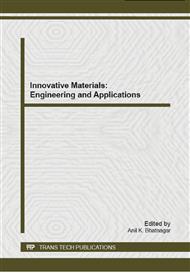[1]
R. E. Newnham, L. J. Bowen, K. A. Klicker, L.E. Cross: Composite piezoelectric transducers, Mater. Eng. Vol. 2 (1980), p.93–106.
DOI: 10.1016/0261-3069(80)90019-9
Google Scholar
[2]
T. R. Gururaja, W. A. Schulze, L. E. Cross, R. E. Newnham, B.A. Auld, Y.J. Wang: Piezoelectric composite materials for ultrasonic transducer applications. Part I: resonant modes of vibration of PZT rod-polymer composites, IEEE Trans. Ultrason. Ferroelect. Freq. Control. Vol. 32 (1985).
DOI: 10.1109/t-su.1985.31623
Google Scholar
[3]
E. K. Akdogan, M. Allahverdi, A. Safari: Piezoelectric composites for sensors and actuator applications, IEEE Trans. Ultrason. Ferroelect. Freq. Control. Vol. 52 (2005), p.746–775.
DOI: 10.1109/tuffc.2005.1503962
Google Scholar
[4]
W. A. Smith, B. A. Auld: Modeling 1-3 composite piezoelectrics: thickness-mode oscillations. IEEE Trans. Ultrason. Ferroelec. Freq. Contr. Vol. 38(1991), pp.40-46.
DOI: 10.1109/58.67833
Google Scholar
[5]
HELEN LAI WAH CHAN, JOSEPH UNSWOTH: Simple model for piezoelectric ceramic/polymer 1-3 Composites Used in Ultrasonic Transducers Applications, IEEE Trans. Ultrason. Ferroelec. Freq. Contr. Vol. 36(1989), pp.434-439.
DOI: 10.1109/58.31780
Google Scholar
[6]
John A. Hossack, G. Hayward. Finite-element analysis of 1-3 composite transducers. IEEE Trans. Ultrason. Ferroelec. Freq. Contr. Vol. 38(1991), pp.618-629.
DOI: 10.1109/58.108860
Google Scholar
[7]
G. Hayward, J. Bennett, R. Hamilton: A theoretical study on the influence of some constituent material properties on the Behavior of 1-3 Connectivity Composite Transducers, J. Acoust. Soc. Am. Vol. 98(1995), pp.2187-2196.
DOI: 10.1121/1.413333
Google Scholar
[8]
Jinwook Kim, Yongrae Roh: Homogenization of PMN-PT/epoxy 1–3 piezocomposites by resonator measurements and finite element analysis, Sensors and Actuators A. Vol. 206(2014) p.97– 106.
DOI: 10.1016/j.sna.2013.12.005
Google Scholar
[9]
R. Ramesh, C. Durga Prasad, T. K. Vinod Kumar, L. A. Gavane, R. M. R. Vishnubhatla: Experimental and finite element modelling studies on single-layer and multi-layer 1-3 piezocomposite transducers, Ultrasonics. Vol. 44(2006) p.341–349.
DOI: 10.1016/j.ultras.2006.02.001
Google Scholar
[10]
IEEE Standard 176-Piezoelectricity (1978).
Google Scholar
[11]
Jue Peng, Haosu Luo, Tianhou He, Haiqing Xu, Di Lin: Elastic, dielectric, and piezoelectric characterization of 0. 70Pb(Mg1/3Nb2/3)O3–0. 30PbTiO3 single crystals, Materials Letters. Vol. 59 (2005) p.640– 643.
DOI: 10.1016/j.matlet.2004.10.053
Google Scholar


